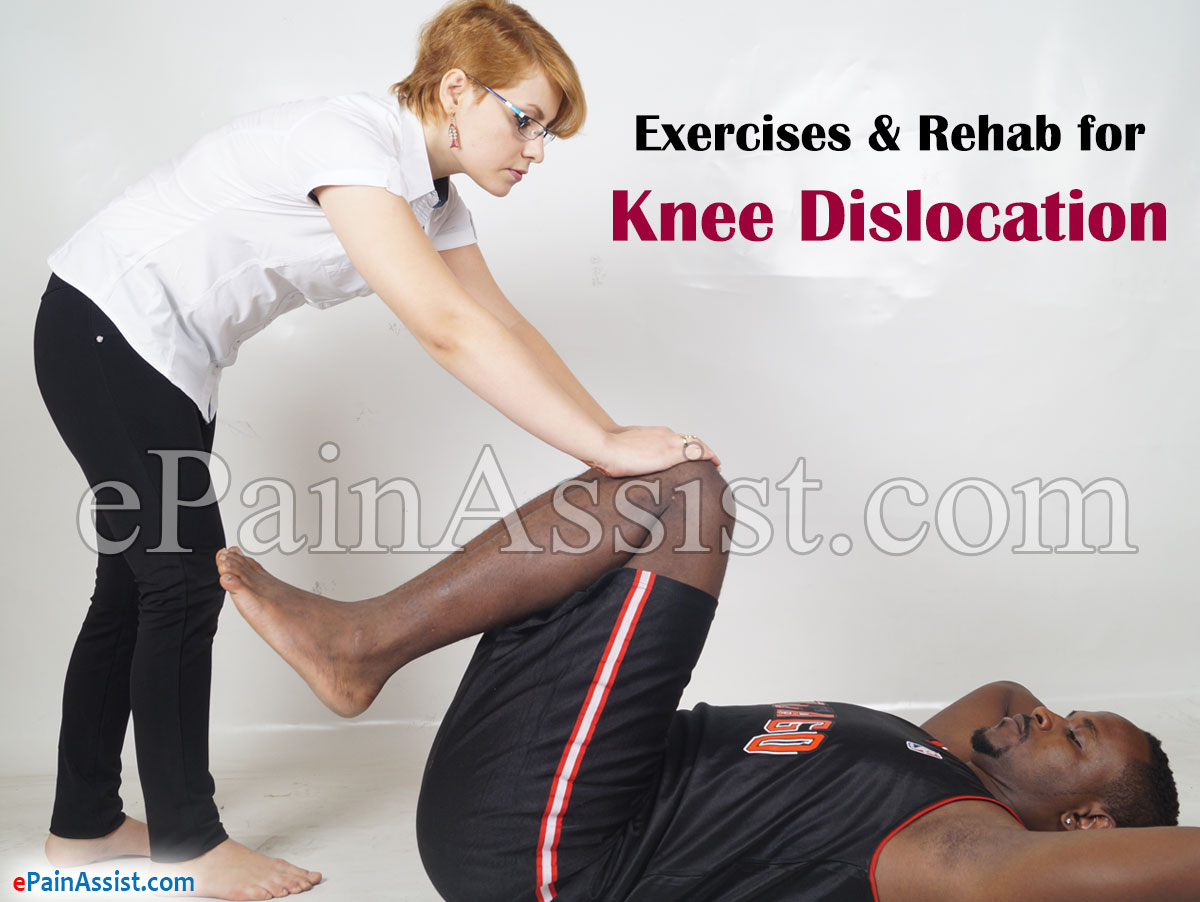Exercises & Rehab for Knee Dislocation or Dislocated Knee
Immediate beginning of limited rehabilitation for knee dislocation or dislocated knee is allowed by conservative treatment. Cardiovascular condition is maintained by a stationary bike that is single legged as the exercise of the mid body is being started. Throughout the process of rehabilitation for knee dislocation or dislocated knee, prevention of patellofemoral problems is emphasized through strengthening the quadriceps.

Knee Flexion of 90 degrees to 45 degrees should be the limit of the range of motion extended by a brace at early exercise so as to decrease the stretch on the knee ligaments that are healing.[1] Performances of exercise for knee dislocation or dislocated knee that are not manually heavy in this range are tolerated. Moderate speed and resistance is the condition of performing these exercise while the pain is decreasing the resistance’s speed should be increasing.
Eight week after sustaining knee dislocation or dislocated knee, the protection the knee demands is minimal and the use of leg-press machine can be started. At this time cycling with both legs and swimming can be started, also exercise that are aimed to increase endurance, like three sets of a hundred quarter squats.[2] High speed exercise should follow these activities with light resistance, like knee flexions or extensions with resistance tubing.
During this period, supplemental exercises like moderate stationery bicycling and jogging are extremely beneficial during the rehab process of knee dislocation or dislocated knee.
Recovery Time for Knee Dislocation or Dislocated Knee
The ligaments that are specifically injured dictate the rehabilitation and the treatment for knee dislocation or dislocated knee. 9 to 12 months is the duration for returning to full activity following knee dislocation or dislocated knee despite being faced with rehabilitation program that is long and arduous.[3]
Prognosis for Knee Dislocation or Dislocated Knee
Knee dislocation or dislocated knee is very serious in general. The possibility of full recovery following knee dislocation or dislocated knee is high but previous capacity of stress adsorption cannot be fully regained. Supportive devices or wraps are commonly recommended by doctors for knee protection and stress reduction on the knee during activities like football playing and skiing especially. Certain activities might have to be avoided, as suggested by doctors, in total, if too much damage has been cause by the knee damage.
- Reconstruction is mandatory for all knee dislocation or dislocated knee due to major injury that occurs to the artery when a knee has been dislocated and due injury to the ligament that is severe.[4]
- Good results have been yielded after surgery and appropriate treatment. In most case, the knee returns to almost its former position. Chronic pain is a problem that is common. A rehabilitation program that is optimal is best with prognosis.
Changes in Lifestyle for Knee Dislocation or Dislocated Knee
One can ease the discomfort following knee dislocation or dislocated knee treatment by using the following steps:
- Use pain relievers. Ibuprofen (Advil, Motrin IB others), acetaminophen (Tylenol others) and naproxen (Aleve) are examples of over-the-counter medication that may help in pain relieving.
- The range of motion in the joint should be maintained. With the direction of the physical therapist or the doctor, ensure that after two weeks you do some exercise that is gentle in order to help in the maintenance of the range of motion in the injured joint. Still joints can result due to total inactivity.
- Rest the dislocated joint. Avoid movements that are painful and do not do the same activity that brought the injury in the first place.
- Apply heat and ice. Pain and inflammation of the injured joint can be reduced by putting ice. A cold pack should last 15- 20 minutes each.[5] Apply this procedure for a couple of hours in the in the first two days. Sore and tightened muscles can be heated after 2 to 3 days when the inflammation has the improved. Each heat application should be limited to 20 minutes at a given time.
Prevention of Knee Dislocation or Dislocated Knee
In order to prevent knee dislocation or dislocated knee:
- Avoid falls by taking proper precautions. Go for eye test on a regular basis, and if you are under medication to treat knee dislocation or dislocated knee, seek the advice of the doctor on the potential of its effect to cause dizziness. Remove anything with potential to cause hazardous tripping on your pathway and ensure that your home is lighted properly.
- When playing contact sport ensure to wear protective gear.
- Avoid recurrence. Susceptibility to future dislocation is high when one has had a joint dislocation. Improvement of the joint support as recommended by the doctor is by strengthening and stabilization in order to prevent recurrence.
- Try to avoiding accidents that are major. Avoid activities that are risky like motorcycle riding, skiing, or jumping from place that are high. If you have decided to engage in these risky activities, proper instructions should be obtained from experts on how to decrease the risks.
- https://www.ncbi.nlm.nih.gov/pmc/articles/PMC535529/
- https://www.uwhealth.org/files/uwhealth/docs/pdf5/MultiLigament.pdf
- https://www.ncbi.nlm.nih.gov/pmc/articles/PMC4169614/
- https://www.ncbi.nlm.nih.gov/pmc/articles/PMC5609377/
- https://www.mayoclinic.org/diseases-conditions/swollen-knee/diagnosis-treatment/drc-20378134
Also Read:
